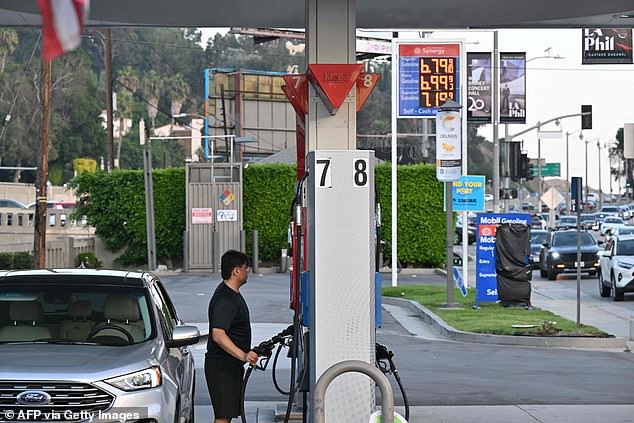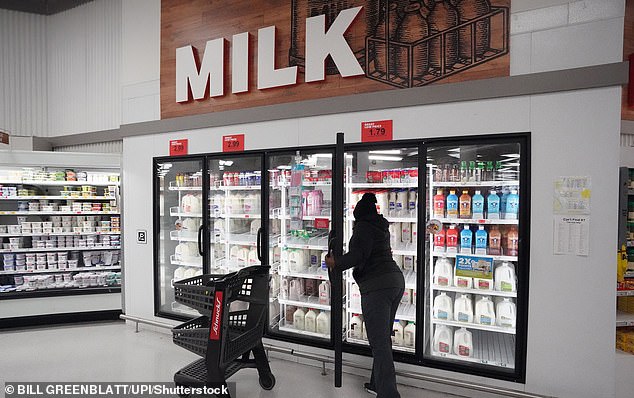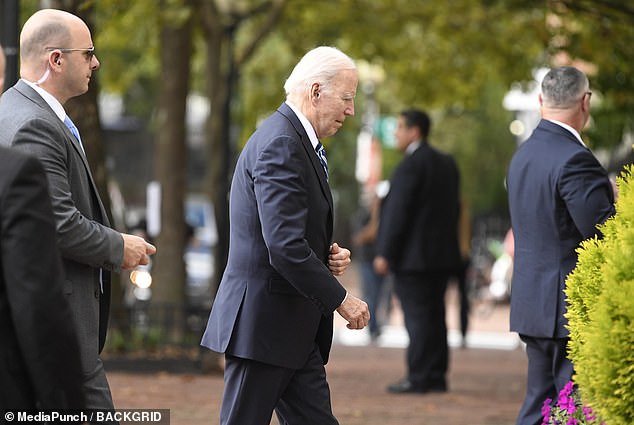Not out of the woods yet: Falling inflation could still sink Biden because Americans are upset by how much more expensive key basics still are than in 2019
Despite falling inflation rates, US consumers are still angry with Biden as prices for basic commodities including gas and milk remain higher than in 2019.
Some have said his re-election campaign’s decision to brand the economy under his name, Bidenomics, looks like an early blunder, as consumers express disappointment with his handling of the economy after the pandemic.
According to Axios Opinion polls show that American perception of the economy is sour, with some Democrats openly criticizing Biden’s campaign strategy, which appears to be in denial of current events.
The disappointment stems from the idea that consumers are typically focused on the absolute price of things they need in their daily lives – and that remains high.
While prices for many items are rising more slowly this year than last, they remain well above pre-COVID-19 pandemic prices and don’t seem likely to return anytime soon.
Despite falling inflation rates, US consumers are still angry with Biden as prices for basic commodities including gas and milk remain higher than in 2019
According to the Ministry of Labor, the consumer price index stood at 3.7 percent in August, a sharp decline from the peak of 9.1 percent in June 2022.
However, the all-items index rose 3.7 percent for the 12 months ending in August, a bigger increase than the 3.2 percent increase in the 12 months ending in July. Labor Statistics Bureau reported.
For consumers, prices in the supermarket and at the gas station are noticeably higher than in recent history.
According to the Labor Department, a gallon of whole milk averaged $3.93 in August, which was almost $1 or 29 percent higher than in August 2019.
Meanwhile, a gallon of regular unleaded gasoline cost an average of $3.84 last month, up 46 percent from $2.63 per gallon four years earlier, the Wall Street Journal reported.
“Just because inflation has fallen doesn’t mean prices have fallen,” senior economist at Wells Fargo Tim Quinlan told the outlet.
“For consumers, as long as prices remain high, which they are from their perspective, this still weighs somewhat on confidence.”
Joanne Hsu, director of the University of Michigan survey, said Americans are still adjusting after nearly a decade of low inflation leading up to the pandemic.
“Consumers understand that we’re not going back to 2019, but they’re still trying to figure out what this new normal looks like,” Hsu explained to the outlet.
“People are still wondering: Can their incomes keep pace with inflation, or will inflation just continue to erode their living standards?”

Meanwhile, a gallon of regular unleaded gasoline cost an average of $3.84 last month, up 46 percent from $2.63 per gallon four years earlier

According to the Labor Department, a gallon of whole milk averaged $3.93 in August, which was almost $1 or 29 percent higher than in August 2019
Chief economist at RSM Joe Brusuelas said price drops are not “desirable for the economy” but consumers are “angry that the price level has moved permanently higher.”
Jayson Lusk, dean of agricultural sciences at Oklahoma State University, told WSJ that prices for some foods could fall if they rise due to specific headwinds for the industry.
Using bird flu as an example, he noted that a dozen eggs rose from $1.93 in January 2022 to $4.82 in January 2023, but dropped to $2.04 in August.
Lusk said prices for groceries and dining out will likely remain high for a while, but wages will go a long way in helping employers struggle to build a workforce.
“It’s true that what happens on the farm affects food prices, but overall this is a small portion of total food costs,” Lusk said.
‘The labor market remains tight and that puts pressure on prices.
Speak with PoliticsRep. Steven Horsford (D-Nev.) said, “We have to do a better job of making this not so much for one person — for the office of president — but for the people.
“I’ve never understood why you would brand an economy in your name when the economy hasn’t fully recovered yet,” Michael LaRosa, a former spokesperson for Jill Biden, also told the publication.
Meanwhile, liberal economist James Galbraith wrote, “Whatever stories Americans hear about the strength of the economy under President Joe Biden will not persuade them to look beyond the issue of their own living standards.”

Biden’s economic approval rating stands at 37 percent, with 59 percent of respondents expressing disapproval of his performance according to a new NBC poll
Biden appears to be focusing his campaign on America’s working class and has argued that the country’s economy “leads the world,” crediting his position at the helm for bringing the US back from the brink.
Last month, Biden delivered a speech on Bidenomics in Prince George’s County, Maryland, saying, “For the first time in a long time, we have emerged from our great economic crisis. It’s starting to work for working people.”
As his campaign ads circulate ahead of the looming election, Biden has touted his passage of COVID relief funds, the bipartisan infrastructure bill, the Inflation Reduction Act and funding for semiconductor manufacturing.
His target audience seems unhappy with his efforts to win them over with polls showing that living paycheck to paycheck are disillusioned with the economy.
Biden’s economic approval rating stands at 37 percent, with 59 percent of respondents expressing disapproval of his performance according to a new report. NBC Poll.
The NBC survey found that Republicans have a whopping 21 point lead over Democrats on the economy (49 percent to 28 percent), the largest lead Republicans have had in 32 years.
Meanwhile, Democrats appear to have only a 36 percent to 34 percent lead when it comes to looking out for the middle class, an area where the party typically has a significant advantage.
